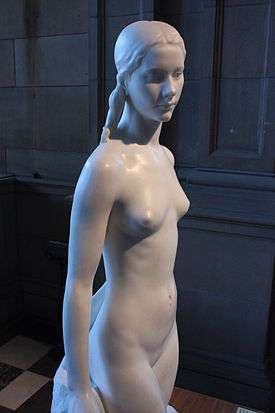William McMillan (sculptor)




William McMillan RA (31 August 1887 – 25 September 1977) was a British sculptor and medal-designer, active in the 20th century. He is said to have been both tall and “extremely handsome”.[1]
Life and career
He was born at 37 Powis Place, Aberdeen, Scotland, the son of William McMillan, master engraver, and Jane Knight.[2]
He studied at Gray's Art School and then at the Royal College of Art, London from 1908 to 1912, under Édouard Lantéri.[3] McMillan joined The Artists Rifles in World War I and was Commissioned into the Oxfordshire and Buckinghamshire Light Infantry on 5 December 1915.
In 1916, he married Dorothy, daughter of the Carlisle architect Maurice Charles Williams. They had no children.
For most of his married life he had a studio at Glebe Place in Chelsea, London and was a member of the Chelsea Arts Club. A faux blue plaque exists at 63 Glebe Place, stating “William McMillan lived here”. Even if this were the correct address, Glebe Place was his place of work not residence.
He was elected an associate of the Royal Academy in 1925, a full member in 1933 and a Senior RA in 1962. From 1929 to 1941 he was Master of the Royal Academy Sculpture School.[4]
From 1940 to 1966 he became involved in a number of important and prestigious public commissions, and became more widely recognised at international level.
He was assaulted and robbed in September 1977, shortly after his ninetieth birthday, and died of his injuries on 25 September 1977[5] in a hospital at Richmond upon Thames. He was buried in Richmond Cemetery.[6]
Honours
He was made a Commander of the Royal Victorian Order (CVO) in 1956. His home city of Aberdeen made him a Freeman of the City and Aberdeen University conferred an honorary doctorate upon him.
Exhibitions
McMillan exhibited at the Royal Academy from 1917 until 1971.
Works
- The Invocation, 1910
- Commissioned to design both the “British War Medal” and “Victory Medal”, 1919
- Aberdeen War Memorial, 1919
- Manchester War Memorial, 1919
- Echt War Memorial, 1920[7]
- Bust of A. G. Macdonnell, author (1923)
- Plymouth Naval Memorial (working with Charles Wheeler, 1924
- Syrinx, Kelvingrove Art Gallery (1925)
- Tam O’Shanter, 1926
- Statuette in green slate, 1927
- Statue of Hugh Oldham, and Youth, 1931, Manchester Grammar School
- Dancer, 1931
- The Birth of Venus, marble, Tate Gallery, 1931
- Statue of J. M. W. Turner, 1936
- The Naked Truth, 1936
- Mother and Child, 1938
- Nereid and Triton with Dolphins, memorial fountain to Admiral David Beatty, 1st Earl Beatty, Trafalgar Square, London, 1948 (one of Britain’s best known fountains)
- Triton and Dryads, memorial fountain to Sigismund Goetze, Queen Mary’s Gardens, 1950
- Statue of King George VI, Carlton Gardens (overlooking The Mall), London, 1955
- Statue of Sir Walter Raleigh, originally in Whitehall, London, 1959, moved to the Old Royal Naval College, Greenwich in 2001
- Statue of Lord Trenchard, Victoria Embankment, London, 1961
- Statue of Thomas Coram, Brunswick Square, London, 1963
- Statue of Alcock and Brown, London Heathrow Airport, 1966
References
- ↑ Oxford National Dictionary of Biography: McMillan
- ↑ Oxford Dictionary of National Biography:McMillan
- ↑ http://www.tate.org.uk/art/artists/william-mcmillan-1612
- ↑ McMillan's file at the RA.
- ↑ Oxford National Dictionary of Biography: McMillan
- ↑ Meller, Hugh; Parsons, Brian (2011). London Cemeteries: An Illustrated Guide and Gazetteer (fifth ed.). Stroud, Gloucestershire: The History Press. pp. 290–294. ISBN 9780752461830.
- ↑ http://warmemscot.s4.bizhat.com/warmemscot-post-25296.html
External links
- http://www.tate.org.uk/art/artists/william-mcmillan-1612
- http://sculpture.gla.ac.uk/view/person.php?id=msib2_1205349090
- http://www.oxforddnb.com/templates/article.jsp?articleid=31396&back=